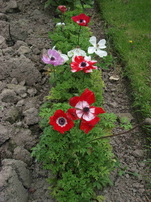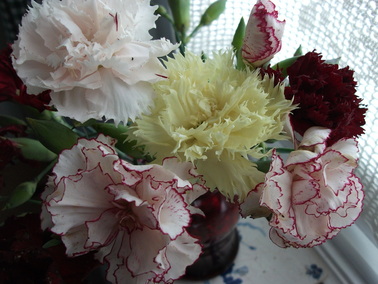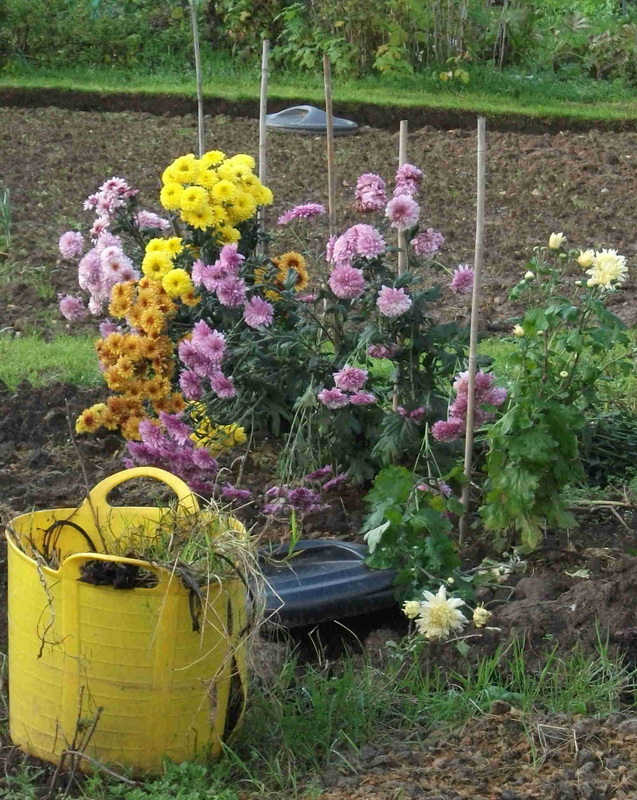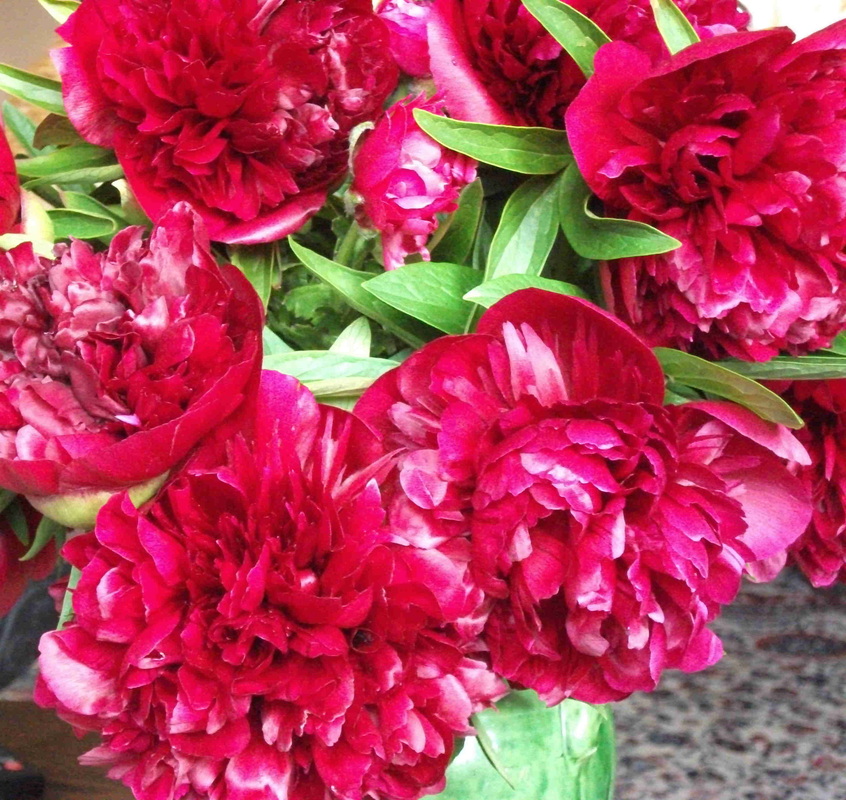Don't let anyone give you any "I thought allotments were for food" flack - you do see it on forums sometimes. Allotments are for increasing your wellbeing and the pleasure of a bunch of flowers is every bit as good for you as the health benefits of brussels sprouts. Both can be bought in the supermarket, and both are much better home-grown. You are allowed to plant up to one quarter of your plot with flowers if you want to. Whether or not you grow flowers depends on your personal preferences, how many mouths you have to feed, and how much ground you have. If you've got this far, we must assume the idea appeals, so read on . . .
Obviously, you can grow any flowers that can be grown in a garden in your allotment - except shrubs (against the rules). But some will give you better value for the space devoted to them than others. These tips are based on practical experience, but you can experiment and we'd be very glad to hear other allotmenteers' suggestions.
BULBS and corms give excellent value for money and are, in general, very little work. With a little planning you can have flowers almost all the year round. A good tip is to choose the cheaper varieties from the catalogues - the reason they are cheap is that they are sturdy, increase well and last from year to year!

ANEMONES brighten up the winter gloom for next to nothing. They will grow in any but the wettest soils, as long as they have full sun. As well as the red and white ones seen here, there are blues, pinks and a selection of mixtures. Soak the corms for 24hours before planting, and put them in a couple of inches down. This photo was taken in november, and they will bllom off and on all through the winter round till Easter. As a pack is just a quid or so in the market, you don't need to feel extravagant, and a row only a couple of feet long will provide you with a constant supply of blooms, so even if you are on one of the wet sites, you can spare a bit of raised bed for them.
DAFFODILS start the spring in late February, if the year is mild. It is temperature which decides the flowering time with them. You can plant daffs in a part of your allotment which is shaded in summer by deciduous trees - they won't mind. "St Keverne" is an old cutting variety and blooms early, holding its head up well on strong stems. It is a classic daffodil bloom and has a sweet scent. You'll find earlier varieties but they can be weak and vulnerable to wind. Choose a couple of later varieties to follow on. We can also recommend "Geranium" (yes, funny name, isn't it) which is a narcissus with a white perianth and orange cup, blooming in April. It has an absolutely cracking scent which will fill your room. Both these varieties will go on tyear after year. When the rows become very crowded, lift the bulbs in August and replant them, spreading them out or giving away the surplus. Always plant daffodils deep - 6ins (15cm) is about right - shallow planting is the commonest reason from them not flowering.
TULIPS are always more expensive than daffs to buy, and if you like the parrot varieties, an arm and a leg. If choosing specialities like parrot tulips, bear in mind again the advice about buying the most old-fashioned, inexpensive types. "Estella Rijnveld" (red and white) and "Blumex" ( mingled red, orange and green) are both old standbys. Otherwise, cottage garden varieties like "Gudoshnik" with its yellow and red flowers, or the original "black" tulip, "Queen of the Night", are all excellent for cutting and will increase over the years. To get the best results from all tulip varieties, plant then in November (not earlier), at least 6ins (15cm) deep. Do not add fertiliser at the time of planting, but a top-dressing of chicken manure (high in phosphates) is good as the blooms go over. Grown like this, in a good sunny spot, they can be left in year after year.
|
RANUNCULUS are ridiculously expensive to buy at the florist, yet astonishingly easy to grow. The mixed packets you see at the shops will come out mostly oranges and yellows - and none the worse for that, but if you want other colours you can buy single colour packs or select individual plants at the market or garden centre. A very small area indeed can accommodate some ranunculus and some anemones. As with anemones, soak the tubers for a few hours before planting. Well-drained, moist soil is the best; on heavy clay create a mini-raised bed for them. You'll get weeks of flowers, after the daffodils have finished, in spring.
|
DUTCH IRISES are amongst the cheapest bulbs to buy, and are a familiar sight in florists. Some lovely colours are available in the catalogues. These bulbs do require a reasonably well-drained soil and are unlikely to give good results on clay. Pick a sunny position where the bulbs can bake after flowering. You'll get one or at the most two flower spikes per bulb.
GLADIOLI are amongst the most flamboyant of flowers, and a tall vase full is a real show stopper. Surprisingly, gladioli are relatively easy and cheap to grow as a cut flower. The bulbs can be planted in spring as soon as the soil starts to warm up; if your plot is damp, put a trowel-full of sand under each bulb and plant them at least 4ins down so they don't blow over in the wind! Apply a light dressing of a general fertiliser (chicken pellets are good)
Though bulbs are inexpensive to buy, it makes sense to dig them up in autumn and store them frost-free in a shed or greenhouse, as the bulbs will go on and even increase from year to year. When you lift them, you will find tiny offsets round the base of the bulb. These can be grown on to flowering size in a couple of years, so they are worth gathering up. Alternatively, if your soil is well-drained (eg Westrees) you can plant them deeply and leave them in.
Only expect to get one good spike per bulb - although as the bulbs get larger they do tend to throw a smaller second spike.
Though bulbs are inexpensive to buy, it makes sense to dig them up in autumn and store them frost-free in a shed or greenhouse, as the bulbs will go on and even increase from year to year. When you lift them, you will find tiny offsets round the base of the bulb. These can be grown on to flowering size in a couple of years, so they are worth gathering up. Alternatively, if your soil is well-drained (eg Westrees) you can plant them deeply and leave them in.
Only expect to get one good spike per bulb - although as the bulbs get larger they do tend to throw a smaller second spike.
ANNUALS, BIENNIALS AND PERENNIALS are all good sources of cut flowers, and are often the most expensive to buy in the shops. A mixed bunch is complete luxury. With careful choice you can have flowers for many months of the year. Be prepared to experiment!
CARNATIONS. The ones you buy in the shops are grown in pots under glass, from plants which have been specially bred for the florist's trade. It may surprise you to learn that Carnations root rather well in water - if you get a bunch and there are some non-flowering sideshoots at the bottom, it's worth trying to root these in water as they will supply you with top quality plants.
However, the easy and obvious way is to grow so-called annual carnations (actually they are short-lived perennials but they'll flower in the first year from seed) in a row outdoors. Start them off from seed in late winter on a windowsill or in a propagator, and prick out into individual pots to plant out in late spring. These plants will flower from late summer till the first hard frosts of winter. If you leave them in the ground, they will produce blooms earlier in spring than new plants - however, they won't go on indefinitely and it is a good idea to grow some every year, taking the old ones out after their second summer.
The rich, spicy scent from annual carnations is extraordinary - the florists' kinds have little scent - and one of these in your buttonhole will really brighten up your day.
However, the easy and obvious way is to grow so-called annual carnations (actually they are short-lived perennials but they'll flower in the first year from seed) in a row outdoors. Start them off from seed in late winter on a windowsill or in a propagator, and prick out into individual pots to plant out in late spring. These plants will flower from late summer till the first hard frosts of winter. If you leave them in the ground, they will produce blooms earlier in spring than new plants - however, they won't go on indefinitely and it is a good idea to grow some every year, taking the old ones out after their second summer.
The rich, spicy scent from annual carnations is extraordinary - the florists' kinds have little scent - and one of these in your buttonhole will really brighten up your day.
|
Best strain - Thompson & Morgan Giant Chabaud double mixed
We have tried every strain of annual carnations over the years. These are undoubtedly the best - seen here are the last few blooms of 2013, picked in November. Though Thompson and Morgan have a name for being pricey, these are worth every penny. Others won't yield these lemon yellows or picotees and will have a lower proportion of doubles. The scent is absolutely stunning! |
|
CHRYSANTHEMEUMS were undoubtedly one of the most popular choices for the allotmenteer in years gone by. they are still widely available and give a good supply of cut flowers till late in the year. However, they are one of the more labour-intensive kinds to grow, as the plants must be lifted each autumn and stored in a greenhouse. The stools from last year supply basal cuttings which are taken and grown on in early spring to supply the next year's collection of plants.
Chrysanthemum plants can be ordered through the post or bought in garden centres. Once you have a stock you can quickly increase them by cuttings. Click here to go to an article by Sarah Raven on how to do it. |
LARKSPUR is an old-fashioned annual, still widely (and cheaply) available, which makes an excellent cutflower. It is a miniature cousin of the Delphinium and has a similar range of colours. Like most annuals, you only need to buy seed once; simply let a few plants go to seed and save the seed for next year.
|
PAEONIES You might think it an appalling extravagance to grow paeonies for cutting in an allotment. Yet they are in many ways ideal. They require very little looking after, carry on improving from year to year, are an excellent cut flower and are prohibitively expensive to buy at the florists - the flower equivalent of asparagus? If you have a neglected clump languishing in shade in your back garden (they don't do as well in shade as the books say!), then dig it up and move it to a sunny corner of the allotment. take care to get the big tubers up intact, and replant almost at the surface (they don't like to go too deep) and give the plant a year to settle sown. It will amaze you with its response.
|
SUNFLOWERS are spectacular on the allotment, and the seeds make very good food for brids in the autumn, just left on the plant. If you are growing for cutting, don'r buy the kind that are advertised as very tall, or the mini ones with fully double flowers. Instead, look for a variety bred for cutting. These produce lots of medium-sized flowers over a long period. Colours available range from lemon yellow to deep mahogany reds. You can start them off by sowing each seed in a little pot, or sow them direct in the open ground. Protect from slugs while young, and be prepared to stake the plants if your site is windy.
SWEET WILLIAMS are an excellent and easy cut flower, giving you scented blooms for several weeks in late spring and early summer. They are a biennial; you need to plant them out in autumn and they can be dug out by the end of June. They make an excellent 'filler' in a patch which will have brassicas planted out in it by late summer, and enjoy the same limey, nitrogen-rich conditions. Sweet Williams are grown from seed; the best strain is 'Old Fashioned Auricula Eyed', with crimson, pink and white eyed flowers. Double strains and ones with a lot of salmon pink in are also available. You are sometimes recommended to sow these in the open ground before moving them in autumn to their flowering position. After many years of experimentation we've found this doesn't work well in Kent. Sweet Williams need constant moisture during the germination period, and a few dry scorching days such as we always get at some stage, will seriously reduce the number of plants or may lead to a total crop failure. Better results are obtained by sowing them in a seed tray somewhere at home where you can make sure they stay well watered. They can then be pricked out into trays or small pots ready for planting out later. Interestingly, wallflowers, which are usually considered similar in their requirements to Sweet Williams, do much better sown on the allotment where drought doesn't bother them, and hate being grown in seed trays.





